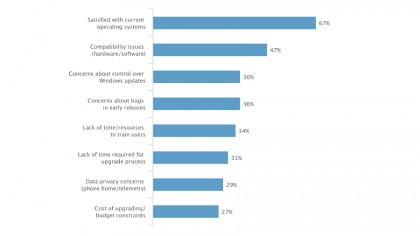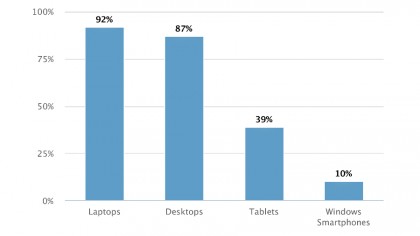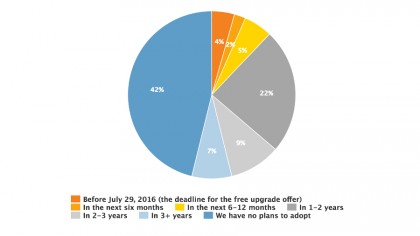Why Microsoft won't hit 1 billion Windows 10 installs
Hint: it's to do with mobile
But it's not quite such bad news for Microsoft as it might sound. While the shift to smartphones and tablets that we've been seeing for several years continues, PC sales are also higher than was predicted (and sales no longer include PCs that qualify for the Bing promotions Microsoft had been using to reduce Windows licence prices). Fewer PCs are being sold, but the drop is less than IDC expected; between April and June 2016, 62.4 million PCs were sold worldwide.

That's helped Microsoft's numbers. The recent financial results beat predictions and Windows was partly responsible for that; revenue from consumer versions is up 27% even though PC sales are flat in western Europe and down worldwide.
Microsoft is predicting that it will make as much or more money in the next three months from Windows (or at least from the More Personal Computing division that includes Windows and devices like Surface and phones). The prediction of $8.7 to $9 billion is close to the $8.9 billion it made in April, May and June. And while it's down from the previous year, when revenue was $11.3 billion, the latest results and the predictions for next quarter are only slightly down from $9.2 billion this time last year.
In other words, while phones and tablets have changed the world, PCs don't dominate any more but they aren't going away either. And that means prospects for Windows 10 are still healthy, says Gillen.
"While this has been spun up as a miss by Microsoft, the reality is the movement to Windows 10 is going especially well, and this product is seeing a faster growth rate (in terms of the percentage of market total) than any previous Windows product.
"For instance, if we look back at Windows 7, one year after release, it accounted for 15% of the worldwide, paid Windows installed base. By comparison, one year in for Windows 10 and it is sitting at 24% of the Windows installed base. By the end of this calendar year, Windows 10 should be at about 33% of the worldwide, paid Windows installed base. Windows 7 didn't get to 33% until it had been on the market for over two and a half years."

The recent Spiceworks survey shows that the business adoption is a little better than that, especially in larger businesses; while Microsoft says 96% of its business customers have "active pilots", 38% of organizations in the Spiceworks study are running Windows 10 on PCs and tablets, although only 10% on phones. 42% of those are still testing, but 58% have it in active use. They picked it for the better performance, the new features, because their existing OS was out of support – and because the upgrade was free.
Sign up for breaking news, reviews, opinion, top tech deals, and more.

That makes 62% of businesses in the survey who aren't running Windows 10; less than half say they won't switch in the foreseeable future, but 11% will upgrade in the next year, 22% in the next two years and 16% after that – which means a steady trickle of business adoption. Laptops and desktops will get the majority of those upgrades; 34% of tablets and 11% of phones in those businesses will have Windows 10 within a year.
So far, Windows 10 growth has actually been slightly better than what Microsoft would need to get to those billion devices by 2018, but that's with the free upgrade offer. Without phones, new consumer PCs and business upgrades will make up the numbers.
It will take a couple more years, and two-in-one tablets will be a much bigger part of Windows 10 family than phones, which means you should expect more features that work with pen – like the new Ink workspace – and connect up a much wider range of phones than just Microsoft's models.
Mary (Twitter, Google+, website) started her career at Future Publishing, saw the AOL meltdown first hand the first time around when she ran the AOL UK computing channel, and she's been a freelance tech writer for over a decade. She's used every version of Windows and Office released, and every smartphone too, but she's still looking for the perfect tablet. Yes, she really does have USB earrings.